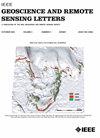Analysis and Simulation of the Micro-Doppler Signature of a Ship With a Rotating Shipborne Radar at Different Observation Angles
IF 4
3区 地球科学
Q2 ENGINEERING, ELECTRICAL & ELECTRONIC
引用次数: 4
Abstract
Differences in the motion of different parts of a target cause the echo signal to contain specific Doppler modulation information, i.e., the micro-Doppler (m-D) effect. This phenomenon provides an effective way to detect targets in marine environments. In this study, based on the establishment of the micromotion model of a rotating surveillance radar and analysis of the m-D frequency, the geometrical optics and physical optics (GO-PO) method and the time-frequency analysis technique are used to obtain the radar cross section (RCS) and m-D signature of a ship with a shipborne radar at different observation angles. The ship, as the main component of the echo, is associated with the main energy. Finding the optimum angle to observe the shipborne radar is of great importance. The results show that the m-D signatures of the shipborne radar are not clear when the elevation angle is greater than 60° but are clear when the elevation angle is less than 55°. Moreover, some motion parameters can be extracted from the m-D signature, such as the period of the ship micromotion. The rotation speed of the shipborne radar can be obtained and is consistent with the set speed. This can help identify and track the key parts of a ship with local motion.舰载旋转雷达不同观测角度舰船微多普勒特征分析与仿真
目标不同部位运动的差异导致回波信号包含特定的多普勒调制信息,即微多普勒(m-D)效应。这种现象为海洋环境下的目标探测提供了一种有效的方法。本研究在建立旋转监视雷达微运动模型和m-D频率分析的基础上,利用几何光学与物理光学(GO-PO)方法和时频分析技术,获得了舰载雷达在不同观测角度下舰船的雷达截面(RCS)和m-D特征。船舶作为回波的主要组成部分,与主能量相关联。寻找最佳观测角度对舰载雷达的观测具有重要意义。结果表明:舰载雷达在仰角大于60°时m-D特征不清晰,在仰角小于55°时m-D特征清晰;此外,还可以从m-D特征中提取一些运动参数,如船舶微运动的周期。可以得到与设定速度一致的舰载雷达转速。这可以帮助识别和跟踪船舶局部运动的关键部分。
本文章由计算机程序翻译,如有差异,请以英文原文为准。
求助全文
约1分钟内获得全文
求助全文
来源期刊

IEEE Geoscience and Remote Sensing Letters
工程技术-地球化学与地球物理
CiteScore
7.60
自引率
12.50%
发文量
1113
审稿时长
3.4 months
期刊介绍:
IEEE Geoscience and Remote Sensing Letters (GRSL) is a monthly publication for short papers (maximum length 5 pages) addressing new ideas and formative concepts in remote sensing as well as important new and timely results and concepts. Papers should relate to the theory, concepts and techniques of science and engineering as applied to sensing the earth, oceans, atmosphere, and space, and the processing, interpretation, and dissemination of this information. The technical content of papers must be both new and significant. Experimental data must be complete and include sufficient description of experimental apparatus, methods, and relevant experimental conditions. GRSL encourages the incorporation of "extended objects" or "multimedia" such as animations to enhance the shorter papers.
 求助内容:
求助内容: 应助结果提醒方式:
应助结果提醒方式:


